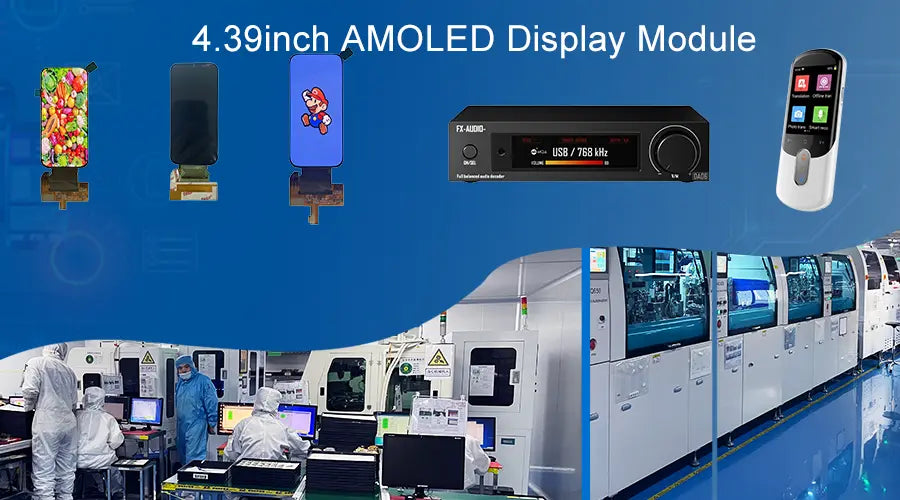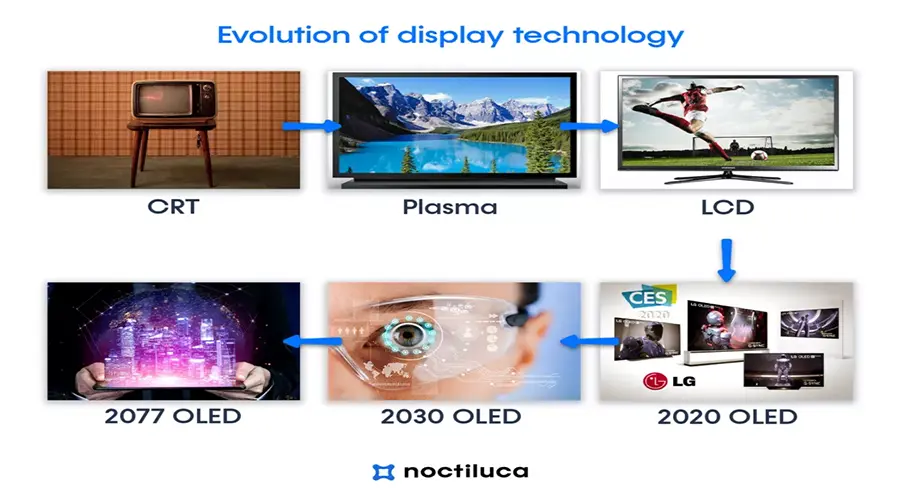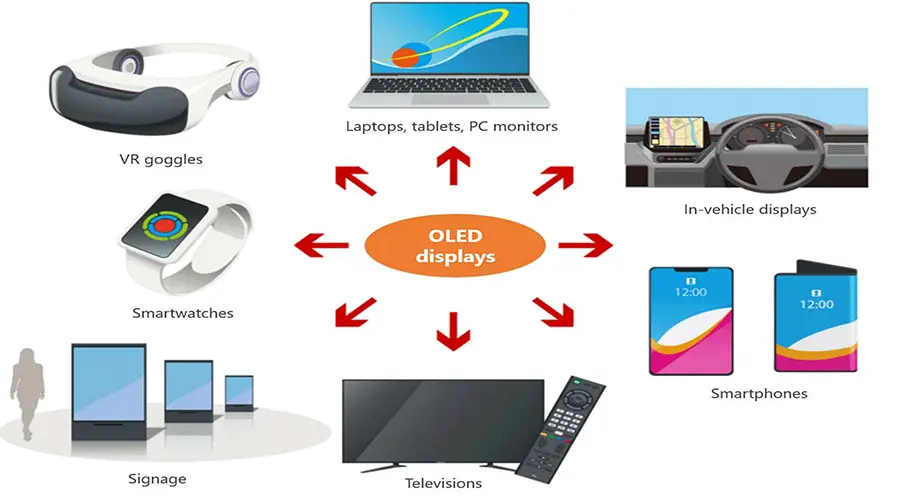OLED Display (0.96–8 inch) Overview and Core Advantages for Embedded and Consumer Products
In-depth guide to OLED display selection for wearables, IoT, automotive, industrial, medical, and smart home.
Table of Contents
1. OLED Display Overview and Core Advantages
Organic Light-Emitting Diode (OLED) displays are self-emissive, meaning each pixel generates its own light when electrically stimulated. Unlike LCDs that require a backlight, OLEDs produce true blacks, infinite contrast, and ultra-fast response times, making them ideal for high-end embedded systems and consumer electronics.
Key advantages of OLED technology include:
- Ultra-High Contrast Ratio: True black levels (1,000,000:1 or higher) due to pixel-level light control.
- Wide Viewing Angles: Up to 178° without color shift or brightness loss.
- Fast Response Time: Microsecond-level response, eliminating motion blur.
- Thin & Lightweight: No backlight layer, enabling flexible and ultra-thin designs.
- Low Power Consumption: Especially with dark UIs; black pixels are turned off completely.
- Excellent Color Reproduction: Wide color gamut (up to 100% DCI-P3).
OLEDs are widely used in smartwatches, medical monitors, automotive dashboards, industrial HMIs, and portable test equipment. However, they are sensitive to moisture and prolonged static images, so proper encapsulation and UI design (e.g., pixel shifting) are essential for longevity.

2. 0.96–1.3 inch OLED: Ideal for Wearables & IoT Devices
Displays in this size range are commonly used in fitness trackers, smart rings, portable sensors, and compact IoT devices. They typically feature resolutions of 128×64 (monochrome), 128×128, or 132×64 (color), with active areas ranging from ~24mm to ~33mm diagonally.
These small OLEDs are usually driven by low-power microcontrollers (MCUs) such as ESP32, STM32, or nRF52, using either I2C or SPI interfaces. Monochrome variants (white, yellow, or blue) offer the longest lifespan and lowest power consumption.
Design Tips:
- Use Dark Backgrounds: Significantly extends display life and reduces power draw.
- Avoid Static Content: Implement screen timeout or pixel shift to prevent burn-in.
- Optimize Refresh Rate: Only update changed pixels to save energy.
- Choose PM-OLED: Passive Matrix OLED is cost-effective for small sizes.

3. 1.5–2.8 inch OLED: For Portable & Handheld Devices
This size range is ideal for handheld meters, portable medical devices, audio players, and industrial handheld terminals. Resolutions include 128×160, 240×240, and 240×320, supporting richer UIs and icons.
These displays typically use SPI interface for faster data transfer, enabling smooth animations and responsive touch feedback (if equipped with a touch panel). Some models support partial screen updates and sleep modes for battery optimization.
Applications:
- Portable ECG monitors
- Smart audio recorders
- Barcode scanners
- Handheld test equipment
- POS terminals

4. 3–5 inch OLED: Automotive & Advanced HMIs
Displays in this range are increasingly used in automotive clusters, infotainment systems, and advanced human-machine interfaces (HMIs). With resolutions up to 720×1280 (HD), they deliver crisp graphics and support multi-window layouts.
These panels typically use MIPI DSI interface, requiring a more powerful processor (e.g., i.MX6, Raspberry Pi, or automotive-grade SoC). They are built with enhanced durability for temperature extremes (-30°C to +85°C) and high brightness (up to 1000 nits) for sunlight readability.
Key Features:
- High brightness & anti-reflective coating
- Wide operating temperature range
- Touch overlay (capacitive or resistive)
- Automotive-grade reliability (AEC-Q100)
- Support for Android Auto / CarPlay interfaces

5–8 inch OLED: Industrial, Medical & Professional Displays
Large-format OLEDs are used in medical imaging devices, industrial control panels, and professional monitoring systems. These displays offer high resolution (1080p or higher), excellent color accuracy, and long-term reliability.
Due to their size and pixel count, they require MIPI DSI or LVDS interfaces and significant processing power. Many models include EMI shielding, optical bonding, and glove-touch support for harsh environments.
Use Cases:
- Medical ultrasound & endoscopy monitors
- Industrial PLC HMIs
- Military & aerospace displays
- Professional video monitors
- Smart home control panels

5. Interface Comparison: I2C vs SPI vs MIPI DSI
Choosing the right interface is critical for performance, power, and MCU compatibility.
| Interface | Speed | Pin Count | Use Case |
|---|---|---|---|
| I2C | Low (~100–400 kHz) | 2 pins (SDA, SCL) | Static UIs, small monochrome OLEDs |
| SPI | Medium (10–50 MHz) | 4–6 pins | Color OLEDs, animations, medium resolution |
| MIPI DSI | High (hundreds of MHz) | 4+ lanes (differential pairs) | High-res color displays, automotive, industrial |
6. Key Specifications by Size Range
| Size (inch) | Typical Resolution | Interface | Brightness (nits) | Power (typ.) |
|---|---|---|---|---|
| 0.96–1.3 | 128×64, 128×128 | I2C / SPI | 100–200 | 0.05–0.2W |
| 1.5–2.8 | 240×240, 240×320 | SPI | 200–400 | 0.3–0.8W |
| 3–5 | 480×800, 720×1280 | MIPI DSI | 500–1000 | 1.5–3W |
| 5–8 | 1080×1920, 1200×1920 | MIPI DSI / LVDS | 400–800 | 3–6W |

7. Frequently Asked Questions
Q: Can OLED displays be used in sunlight?
A: Yes, with high brightness (500+ nits) and anti-reflective coating. Larger automotive and industrial OLEDs are designed for outdoor visibility.
Q: How to prevent OLED burn-in?
A: Use dark themes, avoid static content, implement screen timeout, and use pixel shift or logo dimming features if available.
Q: Are OLEDs suitable for medical devices?
A: Yes, especially for imaging and diagnostics, due to high contrast and color accuracy. Ensure the model meets medical safety standards (IEC 60601).
Q: What is the typical lifespan of an OLED?
A: 10,000 to 30,000 hours to half-brightness, depending on usage, brightness, and pixel usage patterns.
Next Steps: Browse & Order OLED Displays
Explore the full range of OLED Display (0.96–8 inch) for your project. Filter by size, interface, resolution, and touch capability.
Need help selecting the right display? Contact our engineering team for technical support.





댓글 남기기
이 사이트는 hCaptcha에 의해 보호되며, hCaptcha의 개인 정보 보호 정책 과 서비스 약관 이 적용됩니다.